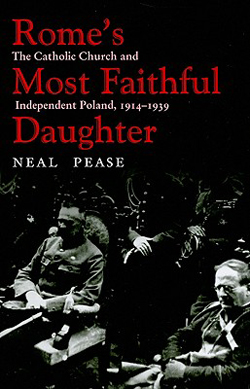 Rome’s Most Faithful Daughter:
Rome’s Most Faithful Daughter:
The Catholic Church and Independent Poland, 1914-1939
By Neal Pease
Ohio University Press, Athens, Ohio
2009, 208 pages
ISBN 978-0-8214-1855-0
Poor Poland. When dictators, absolute monarchs and various armies weren’t giving it a hard time then politicians and writers of various persuasions took over where force of arms left off.
Historian Neal Pease examines the words and deeds that have given shape to Poland’s image and, better still, he also examines words and deeds to reveal something about the reality behind the image.
While it can be vaguely amusing to read that the New York Times once declared Poland to be Rome’s most faithful daughter, and that Polonia semper fidelis was widely accepted as absolute fact, endowing a nation with such profound religious sentiment comes with a price. Consider the words of British writer, G. K. Chesterton, a great admirer of Catholic Poland. He warned that “a flood threatens the West from the meeting of two streams, the revenge of Germany and the anarchy of Russia… [and, he proclaimed, there was]…only one possible dyke against such a flood, which is… the might and majesty of Poland.”
Chesterton’s style was a bit florid but the words were, unfortunately for Poland, prescient. Still, while Chesterton and others agreed about Poland’s Christian virtues (or faults, depending on one’s point of view), Rome, i.e. the Vatican, was often at odds with Poland’s Church. At the same time, the Vatican was often on very good terms with Poles of a secular persuasion.
And therein lies the fascinating mix of cooperation, intrigue, and personalities as the triangle of Polish state, the Vatican and local church authorities all vie for power and influence. The Vatican was not only a religious institution, after all, but was also recognized as a state, a recognition that Poland had not enjoyed for over a century. During that long period of partition and national oblivion, the Vatican paid scant attention to the Polish church, preferring to bestow its attention on the Great Powers, Vienna and Berlin and, in a different way, on St. Petersburg.
While Rome ignored Poland, the Polish church concentrated on its own concerns and a people who, (at the risk of indulging another fond image), largely resisted foreign dictates, the Poles were quite capable of ignoring Rome. It was not until the break-up of the empires seemed quite likely, and the Bolshevik rise to power seemed imminent, that Rome decided to pay more attention to Poland, seeing it as a possible instrument in promoting its own foreign policy and its hopes of expansion to the east.
This political landscape served as a stage for great drama with a cast of characters that included the charismatic and astute Polish statesman, Józef Piłsudski, the Polish nationalist Roman Dmowski, the fiery head of the Armenian church in Poland, Bishop Teodorowicz and the aristocratic Bishop Sapieha of Kraków, two archbishops, Kakowski and Dalbor, who had been neither particularly noble nor fiery while holding their positions in the German and Russian partition zones, and a large number of supporting players. Together with a succession of Popes, including the surprising election of the first il Pappa Polacco (not John Paul II – but you’ll have to read the book if you’re curious) to the wartime Pope, Pius XII, and their emissaries, the cast played out its drama of conflict over church and state, religion and national interest, local loyalties and hierarchical claims.
It is impossible to summarize the complex history that unfolds with gripping tension and wonderful detail in Professor Pease’s marvelous book. In his introduction, Pease states that he undertook the research into this subject because his curiosity was piqued. Indeed the reader feels this because the revelations come as fresh discoveries and not as an exercise to prove a position already held.
Based on extensive research in the archives of four countries, including recently open Vatican archives, Rome’s Most Faithful Daughter is a riveting read that combines an engaging style with academic rigor. It should travel easily beyond the confines of academe and grace the bookshelves of anyone interested in Poland, in the Vatican, in church-state relations, and the ambitions, friendships and rivalries of men and institutions.
Anyone who has read this book will certainly hope that Neal Pease is working on the next installment.
CR




Very interesting book, very good review.